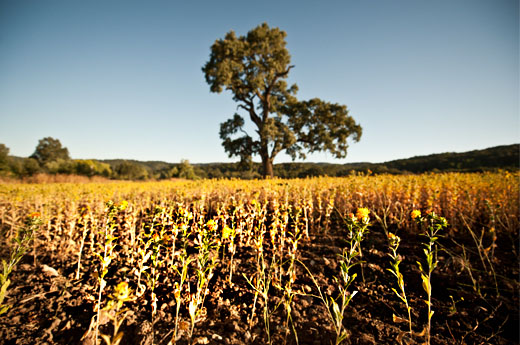 by guest blogger Bob Quinn, organic farmer and president of Kamut International
by guest blogger Bob Quinn, organic farmer and president of Kamut International
There is an increasing debate these days about displacing food production with fuel production, especially in corn country. Many are concerned that the increased demand for grain for ethanol production increases prices for corn and therefore drives all grain prices higher—which leads to increases in the cost of food. Besides that, if you do the math, there’s no way that we can grow enough fuel to run all the industry, businesses, transportation, and homes in this country. If we really want renewable energy, I believe a better long-term solution lies in expanding wind- and solar-generated electricity and in perfecting hydrogen fuel cells and high-capacity storage batteries. Of course, this is futuristic. In the meantime, however, we can grow fuel for our farms with no decrease in food production right now.
Rather than replacing gasoline with ethanol, on our farm we are looking at substituting straight vegetable oil, not biodiesel, for diesel fuel. We grow high-oleic safflower, which has been 100 percent certified organic since 1991. We believe that by being organic we can produce tastier, healthier food, and farm in a more profitable, sustainable way. We crush our oil seeds and those grown by other nearby organic farmers in our own food-grade production facility on the farm. Then we filter it and sell it locally. Restaurants use it for frying, baking, and even salad dressing. Their customers love the taste of the foods cooked with it. Of course, it costs more to produce it in our small crushing facility, however, because the production and sale are local, we have very little cost in transportation.
We’ve discovered that restaurants are willing to pay more for this oil, not only because of more favorable comments from customers, but also because it has a 35 to 40 percent longer cooking life. In addition, the nutrient components make this oil one of the healthiest types to eat, especially for heart health. Its levels of oleic acid exceed all other vegetable oils, making it better than olive oil in this regard. But that’s the food part of the story, now for the fuel part.
About half of our oil is sold to restaurants. When they’re finished with it, we pick up the waste oil as we deliver their next order and bring the waste back to the farm, where we de-water, centrifuge, and filter it. We then put it in our tractors to help produce the next crop of safflower seed, as well as other crops that we raise, such as ancient wheat, and market it under our Kamut trademark. Our tractor has been modified to allow it to burn 100 percent straight vegetable oil (SVO).
The vegetable oil’s viscosity must be reduced to nearly match that of diesel before the oil goes into the fuel-injection system of the engine. The engine is started and warmed up on diesel fuel, which is held in a small fuel tank attached to the tractor. When it reaches the proper temperature, valves automatically open to switch the fuel source from the small diesel tank to the large SVO tank. The power generated by SVO is about 94 percent that of diesel; emissions are a little lower. Before the tractor is shut off for the day, the procedure is reversed so that the fuel lines are once again filled with diesel, allowing for an easy start the next time the tractor is used.
This closed-circuit food/fuel production system could serve as a model that could be replicated in every farm community throughout the nation. Of course, the type of oil used would vary according to what crop was best suited for that region. For example, different high-oleic oils can be produced using certain varieties of sunflower and canola. It would be an efficient and sustainable way to keep the money spent on fuel by local famers circulating in each local community. It would also lower the cost of fuel to the farmers and guarantee farmers would have fuel to produce our food.
In my mind, not every farm would need to have its own presses, as they could form companies or co-ops with their neighbors. We estimate that 10 to15 percent of a farm’s acreage would be required to produce enough waste oil to run the entire farm. This compares favorably to the days when horses used to power the farm required 25 percent of the land to produce their feed. The beauty of modern, renewable farm-fuel production is that farms would use all their land to produce only food. After the high-oleic vegetable oil portion of this food has been used for deep-fat frying, it’s returned to the farm to be used as fuel. Everybody wins and the debate between food verses fuel is over.
 Bob Quinn owns and operates a third-generation 4,000-acre family farm in North Central Montana. He has a PhD in plant biochemistry from the University of California–Davis. He considers his whole farm, which has been 100 percent organic since 1989, to be his garden and his laboratory as he continues to experiment with cropping systems, home-grown fuel, and a small orchard. In 1986, he introduced Kamut brand khorasan ancient wheat to the natural food marketplace. Bob is active in his church and community and has served on numerous local and national boards. He and his wife, Ann, have been married for 42 years and have five children and 16 grandchildren.
Bob Quinn owns and operates a third-generation 4,000-acre family farm in North Central Montana. He has a PhD in plant biochemistry from the University of California–Davis. He considers his whole farm, which has been 100 percent organic since 1989, to be his garden and his laboratory as he continues to experiment with cropping systems, home-grown fuel, and a small orchard. In 1986, he introduced Kamut brand khorasan ancient wheat to the natural food marketplace. Bob is active in his church and community and has served on numerous local and national boards. He and his wife, Ann, have been married for 42 years and have five children and 16 grandchildren.




Thank you for this great information. I wish every farmer is the world would follow your lead. It is amazing what we can do to save our land, air, water and our lives when we just use common sense and when our goal is a better world for us and our children instead of the goal being more money for a few. This article makes me have real hope for our country/world!!
Interesting information. No doubt windmills would help with things.
Last I heard, the Europeans were working on lab created hamburger meat, kind of heinous if you ask me. I’ll never eat a petri-dish burger. I’m in support of whatever it takes to eat homegrown food. Making it easy on US farmers is something I support too. I’ll admit though, seems an ethanol blend of fuel would be good. The challenge is figuring out what wouldn’t compromise corn food production.
What a wonderful, inspiring article, Bob. It is always captivating to read about creative minds at work. That’s what the future is all about. I wonder if you have read the book, Founding Gardeners by Andrea Wulf? It tells the story of our Founding Fathers passionate interests in gardening and agriculture. During his 7 years of leading the troops Washington would spend his breaks in his tent writing to his estate manager with ideas and plans for the garden at Mount Vernon. Franklin, Jefferson, Adams and more visited gardens wherever their travels took them bringing home new types of plants to try. My guess is that anyone reading your article would enjoy the book!